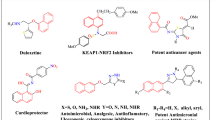Abstract
Nine orally active novel artemisinin derivatives were prepared from artemisinin by four-step synthesis, and the compounds were evaluated in the rodent model using multidrug resistant Plasmodium yoelii nigeriensis. All of the compounds exhibited antimalarial activities with the ED50 ranging from 5.41 mg/kg–12.4 mg/kg. Among them, artemisinin derivative bearing N-(4-hydroxy-3-((4-phenylpiperazin-1-yl)methyl)phenyl) moiety (5f) was found to be the most active compound and was found to be three times more potent than artemisinin (ED50 16.4 mg/kg).


Similar content being viewed by others
References
Brewer TG, Grate SJ, Peggins JO, Weina PJ, Petras JM, Levine BS (1994) Fatal neurotoxicity of arteether and artemether. Am J Trop Med Hyg 51:251
Frenkel YV, Clark AD, Das K, Wang YH, Lewis PJ, Janssen PAJ, Arnold E (2005) Concentration and pH dependent aggregation of hydrophobic drug molecules and relevance to oral bioavailability. J Med Chem 48:1974. doi:10.1021/jm049439i
Peters W, Robinson B (1998) Section IV. In: Zack O, Sande M (eds) Malaria. Academic Press, London, pp 756–771
Lin AJ, Li LQ, Klayman DL, George CF, Flippen-Anderson JL (1990) Antimalarial activity of new water-soluble dihydroartemisinin derivatives. 3. Aromatic amine analogues. J Med Chem 33:2610. doi:10.1021/jm00171a041
Lin AJ, Li LQ, Anderson SL, Klayman DL (1992) Antimalarial activity of new dihydroartemisinin derivatives. 5. Sugar analogues. J Med Chem 35:1639. doi:10.1021/jm00087a021
Peters W, Robinson B (2000) The chemotherapy of rodent malaria. LVIII. Drug combinations to impede the selection of drug resistance, Part. 2: the new generation–artemisinin or artesunate with long-acting blood schizontocides. Ann Trop Med Parasitol 94:23. doi:10.1080/00034980057581
Sriram D, Rao VS, Chandrasekhar KVG, Yogeeswari P (2004) Progress in the research of artemisinin and its analogues as antimalarials: an update. Nat Prod Res 18:503. www.who.int/mediacentre/factsheets/fs094/en/index.html. doi:10.1080/14786410310001620556
Author information
Authors and Affiliations
Corresponding author
Rights and permissions
About this article
Cite this article
Sriram, D., Devakaram, R.V., Dinakaran, M. et al. Aromatic amino analogues of artemisinin: synthesis and in vivo antimalarial activity. Med Chem Res 19, 524–532 (2010). https://doi.org/10.1007/s00044-009-9209-5
Received:
Accepted:
Published:
Issue Date:
DOI: https://doi.org/10.1007/s00044-009-9209-5




